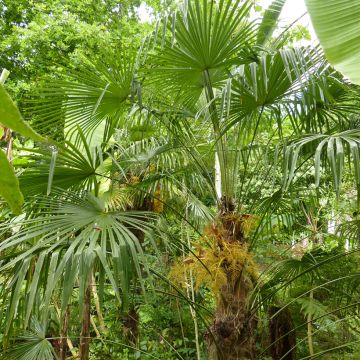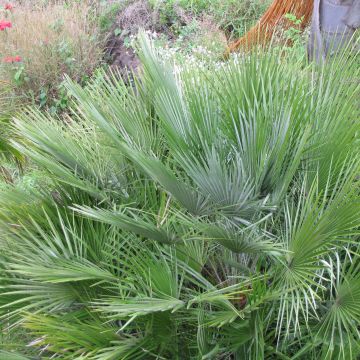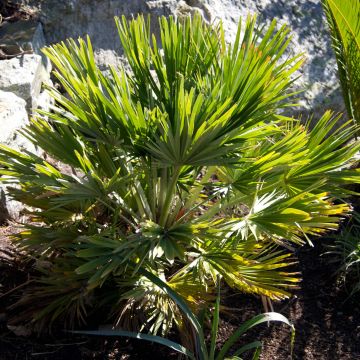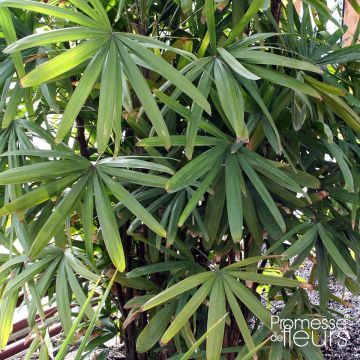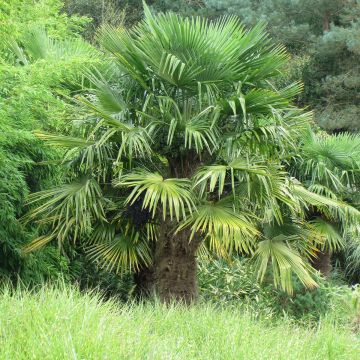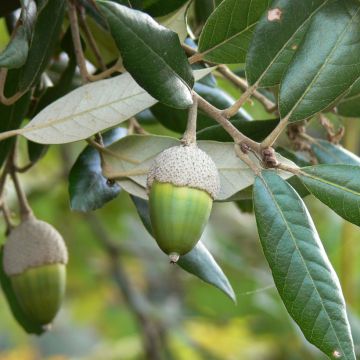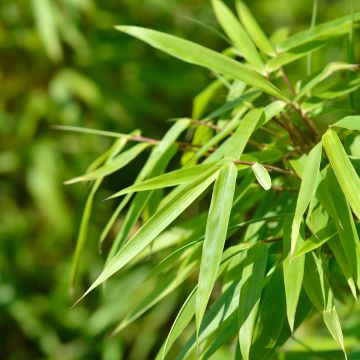

Bismarckia nobilis - Bismarck Palm
Bismarckia nobilis - Bismarck Palm
Bismarckia nobilis
Bismarck Palm
I would like to acquire it. I would like to acquire it now, but I am waiting for its availability.
EDMOND, 24/07/2020
Why not try an alternative variety in stock?
View all →This plant carries a 24 months recovery warranty
More information
We guarantee the quality of our plants for a full growing cycle, and will replace at our expense any plant that fails to recover under normal climatic and planting conditions.
From €5.90 for pickup delivery and €6.90 for home delivery
Express home delivery from €8.90.
Does this plant fit my garden?
Set up your Plantfit profile →
Description
The Bismarck Palm, Bismarkia nobilis in Latin, locally known as the white latanier, is undoubtedly one of the most beautiful palms in Madagascar. Its silhouette is regular, its habit is imposing, and its foliage spectacular: composed of very large fan-shaped leaves, it surprises with its light, bluish, almost metallic colour, which will be even more luminous when the plant grows in warm and dry conditions. Sensitive to frost, it is generally grown in pots, where it will not exceed 3 metres (9 feet 10 inches) in height. This sumptuous palm will make a big impression on a terrace or a large balcony. It requires a lot of sunlight and heat to thrive but tolerates lack of water once established.
Bismarkia nobilis (synonym Medemia nobilis) belongs to the family of Arecaceae. It is endemic to the central and western parts of the island of Madagascar, but cultivated for its ornamental qualities in many tropical or Mediterranean regions worldwide. It is a species that grows in dry areas, savannas, or semi-arid regions. In the wild very old specimens can reach 25 metres (82 feet) in height with a crown exceeding 7 metres (23 feet) in width, dimensions that it will never reach in our climates, especially if cultivated in pots. While well adapted to hot and dry climates, this palm can only tolerate a few brief frosts, around -2°C (28.4 °F). For this reason, it can only be grown in the ground in very sheltered gardens.
The Bismarck palm has slow growth in dry soil, a little faster in consistently moist soil. It develops a short, single, green-grey false trunk (stipe) carrying the remains of dried old leaves. These dried leaves form scales. The foliage is regularly arranged around this trunk and will not exceed 3 metres (9 feet 10 inches) in width. The leaves, which can reach or exceed 3 metres (9 feet 10 inches) in width in nature, are rounded and palmately compound, meaning the leaflets are arranged in a fan shape around a central axis. They are very tough and have a beautiful light grey-blue colour due to the presence of a whitish-waxy film on their upper surface. The lower surface is slightly glaucous. Each leaf is divided into 20 to 30 rigid segments and borne by a petiole reaching 1.80 to 2.40 metres (5 feet 11 inches to 7 feet 11 inches) in length, with a few spines and covered with a very light wax film and brown scales.
This palm is dioecious, meaning there are male individuals that bear only staminate flowers and female individuals that produce only pistillate flowers. The inflorescences are pendulous, brown, and adorned with small yellow flowers. After pollination by bees or wind, clusters of small ovoid fruits measuring 3.5 cm (1.4 in) in diameter, ranging from reddish-brown to dark blackish-brown, each containing a single seed, form on the female plants.
Highly appreciated as an avenue tree in coastal areas of Southern California, Florida, Arizona, Indonesia, and Australia, this Blue Palm from Madagascar is also an absolutely remarkable terrace or patio plant. It grows well in a large container, which should be stored in a cool, bright, and well-ventilated place frost-free during winter. Planted near an entrance or on either side of a gate, or as a standalone near a swimming pool, it will be superb. Fans of graphic and blue plants can plant the Siberian Nolina, the Agave ovatifolia, the Wheeler's Desert Spoon, the Blue Yucca, and other spectacular succulent plants well adapted to dry conditions alongside it.
Report an error about the product description
Bismarckia nobilis - Bismarck Palm in pictures


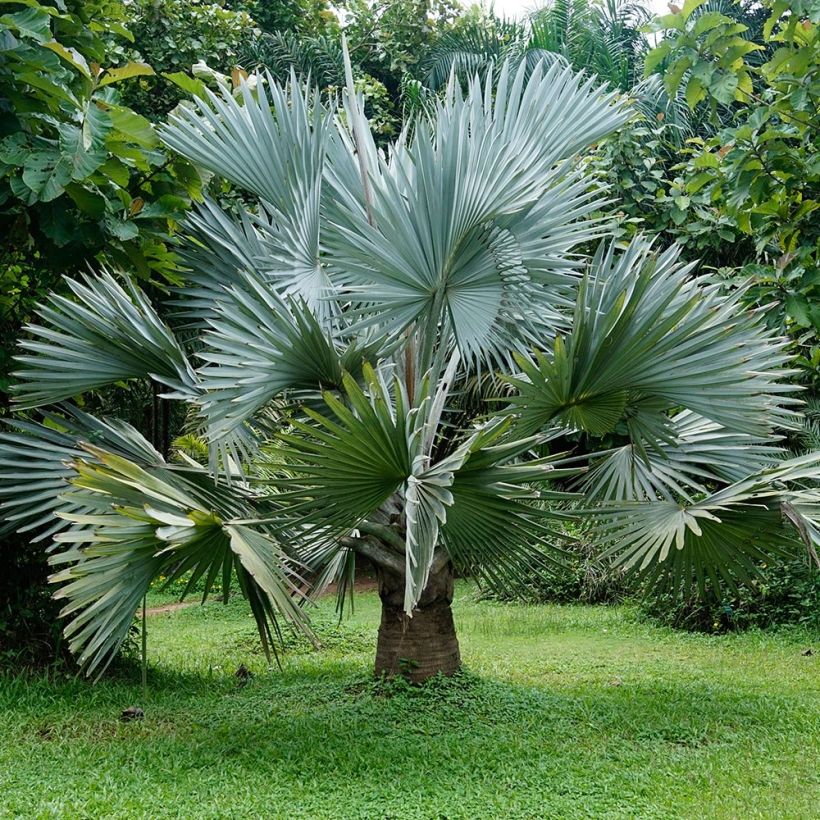

Plant habit
Flowering
Foliage
Botanical data
Bismarckia
nobilis
Arecaceae
Bismarck Palm
Madagascar
Other Palm trees A to Z
Planting and care
This palm tree has slow growth, especially during its early years, and requires sunlight and warmth. In cool soil, it will grow faster but its foliage will be greener and less decorative. Plant Bismarkia nobilis in a very large pot with drainage holes at the bottom and filled with potting soil and garden soil, with a layer of drainage at the bottom (clay balls, pottery shards...). In the ground, regularly water your palm tree for the first 3 years to help it establish itself, it will manage on its own afterwards. In a pot, watering should be regular, abundant but spaced out to allow the soil to dry a little between waterings. Place it in a sunny location and protect it from cold and dry winds. It is easy to grow and requires little maintenance except for pruning the oldest fronds close to the stipe. This species is not very susceptible to diseases if the plant is grown in good conditions. Place your potted palm tree outside from May to September, and bring it indoors to a very bright room from October onwards to protect it from frost. Reduce watering in winter.
Many palm trees are victims of parasites such as the dreaded and widespread Paysandra archon worm, a large butterfly that is present in England. Specific treatments are now available as a preventive measure. The red palm weevil (Rhynchophorus ferrugineus) is present in some areas. The symptoms are as follows: cut, dried or yellowing fronds. These pests attack many species of palm trees, with a fatal outcome: the leaves dry out irreparably and completely as soon as the heart of the stipe hosts larvae.
Planting period
Intended location
Care
-
, onOrder confirmed
Reply from on Promesse de fleurs
Evergreen shrubs
Haven't found what you were looking for?
Hardiness is the lowest winter temperature a plant can endure without suffering serious damage or even dying. However, hardiness is affected by location (a sheltered area, such as a patio), protection (winter cover) and soil type (hardiness is improved by well-drained soil).

Photo Sharing Terms & Conditions
In order to encourage gardeners to interact and share their experiences, Promesse de fleurs offers various media enabling content to be uploaded onto its Site - in particular via the ‘Photo sharing’ module.
The User agrees to refrain from:
- Posting any content that is illegal, prejudicial, insulting, racist, inciteful to hatred, revisionist, contrary to public decency, that infringes on privacy or on the privacy rights of third parties, in particular the publicity rights of persons and goods, intellectual property rights, or the right to privacy.
- Submitting content on behalf of a third party;
- Impersonate the identity of a third party and/or publish any personal information about a third party;
In general, the User undertakes to refrain from any unethical behaviour.
All Content (in particular text, comments, files, images, photos, videos, creative works, etc.), which may be subject to property or intellectual property rights, image or other private rights, shall remain the property of the User, subject to the limited rights granted by the terms of the licence granted by Promesse de fleurs as stated below. Users are at liberty to publish or not to publish such Content on the Site, notably via the ‘Photo Sharing’ facility, and accept that this Content shall be made public and freely accessible, notably on the Internet.
Users further acknowledge, undertake to have ,and guarantee that they hold all necessary rights and permissions to publish such material on the Site, in particular with regard to the legislation in force pertaining to any privacy, property, intellectual property, image, or contractual rights, or rights of any other nature. By publishing such Content on the Site, Users acknowledge accepting full liability as publishers of the Content within the meaning of the law, and grant Promesse de fleurs, free of charge, an inclusive, worldwide licence for the said Content for the entire duration of its publication, including all reproduction, representation, up/downloading, displaying, performing, transmission, and storage rights.
Users also grant permission for their name to be linked to the Content and accept that this link may not always be made available.
By engaging in posting material, Users consent to their Content becoming automatically accessible on the Internet, in particular on other sites and/or blogs and/or web pages of the Promesse de fleurs site, including in particular social pages and the Promesse de fleurs catalogue.
Users may secure the removal of entrusted content free of charge by issuing a simple request via our contact form.
The flowering period indicated on our website applies to countries and regions located in USDA zone 8 (France, the United Kingdom, Ireland, the Netherlands, etc.)
It will vary according to where you live:
- In zones 9 to 10 (Italy, Spain, Greece, etc.), flowering will occur about 2 to 4 weeks earlier.
- In zones 6 to 7 (Germany, Poland, Slovenia, and lower mountainous regions), flowering will be delayed by 2 to 3 weeks.
- In zone 5 (Central Europe, Scandinavia), blooming will be delayed by 3 to 5 weeks.
In temperate climates, pruning of spring-flowering shrubs (forsythia, spireas, etc.) should be done just after flowering.
Pruning of summer-flowering shrubs (Indian Lilac, Perovskia, etc.) can be done in winter or spring.
In cold regions as well as with frost-sensitive plants, avoid pruning too early when severe frosts may still occur.
The planting period indicated on our website applies to countries and regions located in USDA zone 8 (France, United Kingdom, Ireland, Netherlands).
It will vary according to where you live:
- In Mediterranean zones (Marseille, Madrid, Milan, etc.), autumn and winter are the best planting periods.
- In continental zones (Strasbourg, Munich, Vienna, etc.), delay planting by 2 to 3 weeks in spring and bring it forward by 2 to 4 weeks in autumn.
- In mountainous regions (the Alps, Pyrenees, Carpathians, etc.), it is best to plant in late spring (May-June) or late summer (August-September).
The harvesting period indicated on our website applies to countries and regions in USDA zone 8 (France, England, Ireland, the Netherlands).
In colder areas (Scandinavia, Poland, Austria...) fruit and vegetable harvests are likely to be delayed by 3-4 weeks.
In warmer areas (Italy, Spain, Greece, etc.), harvesting will probably take place earlier, depending on weather conditions.
The sowing periods indicated on our website apply to countries and regions within USDA Zone 8 (France, UK, Ireland, Netherlands).
In colder areas (Scandinavia, Poland, Austria...), delay any outdoor sowing by 3-4 weeks, or sow under glass.
In warmer climes (Italy, Spain, Greece, etc.), bring outdoor sowing forward by a few weeks.

































